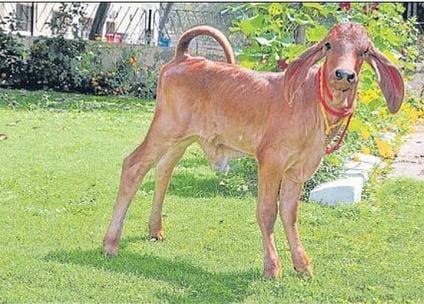Scientists got big success, heifer weight 32 kg and healthy
Pantnagar. Indigenous cow breeds like Gir, Sahiwal, Tharparkar and Red-Sindhi play an important role in the milk industry of India. Milk obtained from cows and buffaloes has made India the largest milk producing country in the world. Low productivity of indigenous cows is a major challenge for sustainable milk production in India. Globally, the application of assisted breeding technology to produce high quality cattle has yielded satisfactory results, which has seen an increase in milk production. Compared to other breeding techniques, animal cloning techniques can play an important role in increasing the number of high-quality animals at a much faster rate and in the conservation of endangered animal breeds. In this direction, the National Dairy Research Institute, in collaboration with the Uttarakhand Livestock Development Board, Dehradun, under the leadership of Dr. Manmohan Singh Chauhan, former Director and Vice-Chancellor of the National Dairy Research Institute, Karnal, has started cloning indigenous cows like Gir, Sahiwal and Red-Sindhi. Started work. It has been a very challenging task to develop animal cloning technology for the conservation and increase of indigenous cows.
Under this ambitious project, a cloned calf of Gir breed was born on 16 March 2023. It weighed 32 kg at birth and is healthy. Gir cow is a famous breed of indigenous cow of India, which is basically found in Gujarat. This breed is being used as a quality improvement of other breeds. Gir cow is more tolerant than other cow breeds, which tolerates extreme temperature and cold easily and is known for its immunity to various tropical diseases. That’s why our native cows are in great demand in Brazil, America, Mexico, and Venezuela.
A team of scientists comprising Dr. Naresh Selokar, Dr. Manoj Kumar Singh, Dr. Ajay Aswal, Dr. S.S. Lathwal, Dr. Subhash Kumar, Dr. Ranjit Verma, Dr. Kartikeya Patel and Dr. Manmohan Singh Chouhan had been working for more than 2 years to develop an indigenous method for producing cloned cows. In this method, eggs are retrieved from a live animal using ultrasound-guided needles and then matured for 24 hours under favorable conditions. Then high-quality cow somatic cells are used as the donor, which are fused to the OPU-derived oocyte. After 8 days of in vitro-culture the developed blastocysts are transferred to the cow. After 9 months the cloned calf or heifer is born.
Doctor. Himanshu Pathak, Secretary, Department of Agricultural Research and Education and Director General, Indian Council of Agricultural Research told that our animals are disease resistant as well as adapted to the hot and humid climate of the country. I congratulate the team for developing an indigenous method for cloning cattle. I hope the team will continue their research to refine the technology and produce more cloned cow calves. Cattle cloning technology has the potential to fulfill the need of high milk yielding indigenous cattle for Indian farmers. Dr. Manmohan Singh Chouhan, Vice-Chancellor of Govind Ballabh Pant University of Agriculture and Technology, Pantnagar was present on the occasion.
Doctor. Dhir Singh, Director and Vice-Chancellor, National Dairy Research Institute, Karnal said that this achievement will help us to expand and initiate research activities for cloning of cattle in India. Animal cloning technology by our scientists is setting new dimensions in the production of quality indigenous animals and in future this achievement will help us to produce high quality animals in India and farmers will be directly benefited from it











